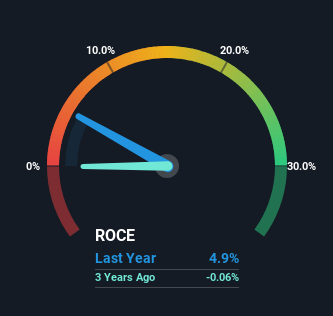Tomoegawa (TSE:3878) Is Doing The Right Things To Multiply Its Share Price

Did you know there are some financial metrics that can provide clues of a potential multi-bagger? One common approach is to try and find a company with returns on capital employed (ROCE) that are increasing, in conjunction with a growing amount of capital employed. Put simply, these types of businesses are compounding machines, meaning they are continually reinvesting their earnings at ever-higher rates of return. Speaking of which, we noticed some great changes in Tomoegawa's (TSE:3878) returns on capital, so let's have a look.
What Is Return On Capital Employed (ROCE)?
If you haven't worked with ROCE before, it measures the 'return' (pre-tax profit) a company generates from capital employed in its business. To calculate this metric for Tomoegawa, this is the formula:
Return on Capital Employed = Earnings Before Interest and Tax (EBIT) ÷ (Total Assets - Current Liabilities)
0.049 = JP¥1.3b ÷ (JP¥46b - JP¥18b) (Based on the trailing twelve months to March 2024).
Therefore, Tomoegawa has an ROCE of 4.9%. In absolute terms, that's a low return and it also under-performs the Chemicals industry average of 6.6%.
View our latest analysis for Tomoegawa

Historical performance is a great place to start when researching a stock so above you can see the gauge for Tomoegawa's ROCE against it's prior returns. If you'd like to look at how Tomoegawa has performed in the past in other metrics, you can view this free graph of Tomoegawa's past earnings, revenue and cash flow.
The Trend Of ROCE
Even though ROCE is still low in absolute terms, it's good to see it's heading in the right direction. The data shows that returns on capital have increased substantially over the last five years to 4.9%. The company is effectively making more money per dollar of capital used, and it's worth noting that the amount of capital has increased too, by 34%. So we're very much inspired by what we're seeing at Tomoegawa thanks to its ability to profitably reinvest capital.
On a separate but related note, it's important to know that Tomoegawa has a current liabilities to total assets ratio of 40%, which we'd consider pretty high. This effectively means that suppliers (or short-term creditors) are funding a large portion of the business, so just be aware that this can introduce some elements of risk. Ideally we'd like to see this reduce as that would mean fewer obligations bearing risks.
What We Can Learn From Tomoegawa's ROCE
A company that is growing its returns on capital and can consistently reinvest in itself is a highly sought after trait, and that's what Tomoegawa has. And given the stock has remained rather flat over the last five years, there might be an opportunity here if other metrics are strong. That being the case, research into the company's current valuation metrics and future prospects seems fitting.
If you'd like to know about the risks facing Tomoegawa, we've discovered 4 warning signs that you should be aware of.
While Tomoegawa isn't earning the highest return, check out this free list of companies that are earning high returns on equity with solid balance sheets.
Valuation is complex, but we're here to simplify it.
Discover if Tomoegawa might be undervalued or overvalued with our detailed analysis, featuring fair value estimates, potential risks, dividends, insider trades, and its financial condition.
Access Free AnalysisHave feedback on this article? Concerned about the content? Get in touch with us directly. Alternatively, email editorial-team (at) simplywallst.com.
This article by Simply Wall St is general in nature. We provide commentary based on historical data and analyst forecasts only using an unbiased methodology and our articles are not intended to be financial advice. It does not constitute a recommendation to buy or sell any stock, and does not take account of your objectives, or your financial situation. We aim to bring you long-term focused analysis driven by fundamental data. Note that our analysis may not factor in the latest price-sensitive company announcements or qualitative material. Simply Wall St has no position in any stocks mentioned.
Have feedback on this article? Concerned about the content? Get in touch with us directly. Alternatively, email editorial-team@simplywallst.com
About TSE:3878
Tomoegawa
Manufactures, processes, and sells electronics parts, display parts, fine particles, functional sheets, and specialty paper products primarily in Japan.
Solid track record and good value.
Market Insights
Community Narratives



